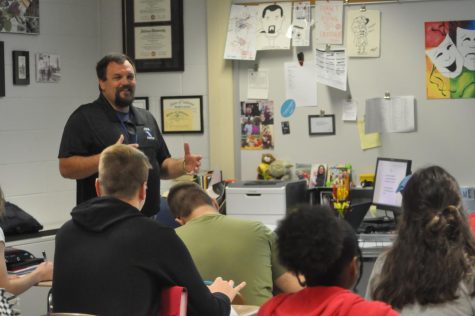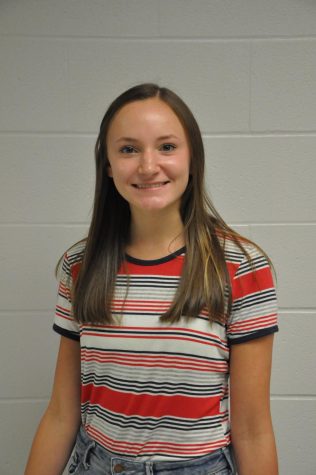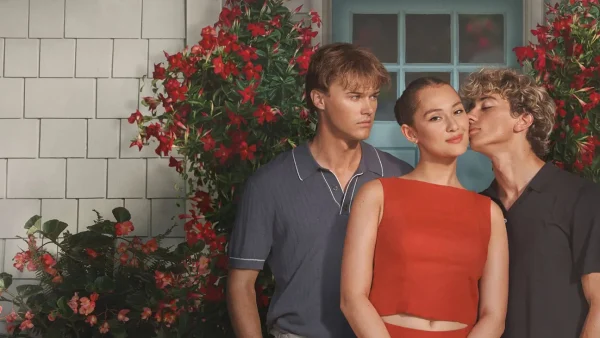English class catches fire, sparks new readers
Huckleberry Finn. The Odyssey. Beowulf. The Scarlet Letter.
Ask any high school student and odds are they’ve read at least one of these classics in an English course. But while they might be the epitome of literature–the ancestors to the books we read today–they lack the ability to connect with the high school students reading them.
Observing this disconnect between students and the text they were reading, English teacher Justin Smith had an idea: an English course centered around contemporary Young Adult literature.

“When I was talking to Mrs. Wisehart about this course… I was teaching British Literature at the time…and it deals with a lot of what I call ‘dead white guy literature,’” said Mr. Smith. “You’re reading Shakespeare and you’re reading all this and it’s great that you read those but it’s so far removed from your average senior’s experience and it’s hard to get them to connect to it.”
From topics covering loss to identity to heartache, Young Adult novels are love letters to high school students, a means of connection, bridging the gap between paper and person.
With this in mind, Mr. Smith collaborated with fellow English teacher Mrs. Wisehart, head of the English department, to create a class built on the foundation of Young Adult Literature.
“I always enjoyed studying novels when I was in college and it’s always been a course that I have wanted to teach,” said Mr. Smith. “When Mrs. Wisehart had the same idea, it was like ‘lightbulb, let’s get together and make this course.’”
Before they could narrow down possible novels to be read and create coinciding coursework to go along with their selections, the first step towards the creation of the class was getting approval from administration.
“Administration here is always looking for new ideas and things that teachers are passionate about that are going to benefit the kids,” said Mr. Smith. “They’re all about getting those types of course selections into the course catalog.”
Mr. Smith and Mrs. Wisehart worked off their passion for novels and wrote up a proposal for the course including their goals for the class and what standards it would cover. The proposal was then submitted to the administration where it was approved and placed into the course selections for the 2018-2019 school year.
From there, the two teachers made lists of their favorite Young Adult novels and read each title, eventually narrowing it down to the handful of novels read in the class today.
The first run of the class was last year where students read novels such as Everything, Everything by Nicola Yoon, Scythe by Neil Shusterman and Jurassic Park by Michael Crichton.
But as the genre of Young Adult literature evolves, so evolves the class.
“We can change out books if we want to and put other books in as Young Adult evolves,” said Mr. Smith. “Jurassic Park is an example of that. It didn’t go very well last year, so we took it out and now we’re trying this other unit. Maybe in a few years, when one of these other books gets old, let’s change it out and put something else in so we can keep things fresh and current.”
It’s this mentality of currency–of keeping the novels read in the class relevant to the average high school student–that makes the reading more than an assignment to cross off a list of to-dos.
“I think that they [students] can find a connection with the newer [novels], something that they might be going through that sparks them to find something more in that genre or by that author if they feel touched by it and it’s impacting their life somehow,” said librarian Penny Shilling.
Since it’s first run last year, the class has already seen a dramatic increase in popularity, with more students enrolled and more sections of the class taught. But it isn’t simply about more names called out during roll-call or fewer seats empty in a classroom.
It’s about the passion for literature sparking within otherwise resistant readers.
“Last year I had students in first semester that came back in second semester and they had read the sequels to some of the books and they had branched out and read other books,” said Mr. Smith. “That’s the tell-tale sign that we’re being successful; that the kids are branching out on their own, that they’re excited about what they’re reading. That doesn’t show in standard or on a test, but that’s what I want to see.”

Remmington is a senior at Carroll. This is her third year on the newspaper staff and second year as co-editor in chief. She is an avid writer...





